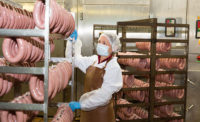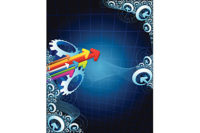Processing Tech
Automation in the food industry is knocking

Food production robots solve two problems: preventing worker injuries caused by machines or repetitive motions and improving consistency and speed in cuts. Now, wash-down robotic systems are also preventing food contamination. Improved sanitation and design on slicers, dicers and cutters in general continues to motivate the food industry.
In a conversation with a maintenance supervisor, a front-line supervisor said, “I never have to worry about staffing my production lines.” The maintenance supervisor replied, “I have it easier than you because all of my maintenance technicians are well trained, possess unique skills, and we don’t have any mechanical downtime.”
It is highly doubtful anyone who has worked in our industry has overheard or participated in such a conversation.
Our industry is bombarded by many issues that consume daily operations and strategic planning. Labor challenges have increased in our industry since the mid-1970s. Labor issues are nothing new to our daily operations. Wages, benefits, facility location, working environment and competition are easily identified as contributors to labor challenges.
The global economy continually changes, and agribusiness has seen the interconnectivity of markets complicate supply chains. We need to seriously evaluate our industry and how to address labor and automation. Five issues must be acknowledged:
- turnover costs are increasing;
- the current labor market is unsustainable;
- non-value labor needs to be eliminated;
- automation is inevitable;
- automation is a net job creator.
Turnover costs are increasing
As turnover rates increase, costs increase exponentially. Direct and indirect costs place a tangible burden. How much time and money goes into recruiting, hiring and managing production line workers or maintenance technicians? Hiring the right people is always a challenge, as one does not know how long a person will stay or perform as expected. Competition for workers continues to intensity. What is driving workers to stay or leave our industry?
The current labor market is unsustainable
Sustainability is a buzzword bandied around by many businesses. Typically, the word is used for physical resources such as materials. But what is a sustainable workforce? There needs to be a source of reliable workers. A “warm body” will not suffice to fill the jobs on a production line. Continually hiring and placing an individual in a production environment will not be the best business plan and cannot be sustained for the long term. The question one should ask is, “How much are we spending on shared services such as human resources to maintain our work force?” One would be surprised by how much is spent on an unsustainable labor force.
Non-value-added labor needs to be eliminated
What is non-value-added labor? It is labor your organization absorbs to perform tasks that do not add value to the product or for the customer. For example, an employee moves a fully packaged box from the production line to another workstation. At that workstation, another employee weighs the box and places a label on the box. Finally, another employee puts the boxes on pallets.
So often we observe this type of labor consuming a significant portion of the total cost. So why don’t facilities automate these processes? Processes change, production needs and layouts are modified based on customers and changing production needs. Long-term solutions require a serious evaluation of worksites by experts who can provide short-term and long-term solutions. Inevitably, decisions come down to the capital cost and the return on investment (ROI). The ROIs are critical measures when determining how an organization should approach automation.
Automation is inevitable
It is fun to watch movies that depict robots performing complex tasks, but these scenes are not easily replicated on the production floor. Yes, technology has progressed in our industry but not as rapidly as necessary. Now we are faced with pressure on multiple fronts to increase production, improve food safety and advance workers’ safety. Consumers also pressure processors to improve products at a reasonable price. Reasonable can be argued from either side of the exchange, but it truly is the cost the market is willling to pay for those improvements.
A recent news report featured a six-axis robot flipping burgers at a fast food restaurant in California. The robot was eventually removed because it couldn’t keep up with the lunchtime demand and speed, but it was technically sound and I am sure improvements will be made to reinstall the flipper soon. More robots and artificial intelligence (AI) will be implemented in our industry whether one wants to believe it or not. As I flipped burgers at McDonald’s in the early 1980s, never did I think that more than 36 years later, my flipping skills would be replaced. Why did it take so long?
Automation is a net job creator
We cannot look at the future of our industry and solely rely on an endless availability of labor performing low-skilled jobs. When the blanket statement “Automation will eliminate jobs” is made, I take pause and evaluate what is necessary to manufacture, install and maintain automation in food processing facilities? The bigger picture of automation should be viewed as shifting tasks from boring and highly repetitive to highly technical, enriching careers instead of “just a job”.
The net effect of automation will be a job creator as the supply chain of developers, manufacturers, installers and maintainers will bring skilled jobs and higher wages to workers. Higher wages do not mean that the net effect on costs will increase. Conversely, the payroll should decrease. Why? Would you rather pay average wages to three non-skilled workers or higher wages to two highly skilled workers? A narrow-minded person may say the three non-skilled workers would be a better choice, but economics proves it is better to pay two higher-skill workers.
“But that goes against your argument that there will be a net increase in jobs due to automation.” No, not really. The amount of turnover in facilities is increasing and labor is not readily available. Stabilizing the workforce will be one end result from adoption of automation.
In conclusion
Automation has arrived and been accepted in most industries. Our industry is typically a high-volume, low-margin business, so one hears the argument automation is too high of a capital cost to be beneficial. But a sound strategic business decision would be to plan on incorporating automation in a staged manner to provide stability in labor staffing, improve support jobs and effectively increase efficiencies. NP
Automate for smarter solutions
By Sean Riley, PMMI
The Association for Packaging and Processing Technologies
As pressing concerns such as food safety and production speed remain top of mind for meat and poultry manufacturers, automation is becoming more prevalent. Robotic technology, once only found on the back end of the line — or on the horizon of a 10-year plan — is making its way into every part of packaging operations. The benefits of these technologies are becoming ever more evident to meat product manufacturers, who depend on their equipment to help them provide reliably consistent, high-quality, safe products. According to the 2017 Trends Shaping Meat, Poultry and Seafood: Market Segment Report from PMMI, The Association for Packaging and Processing Technologies, 96 percent of companies interviewed plan to advance automation in the next three to five years, with food safety and cleanliness cited as major drivers for this increase.
Automation to fight contamination
In the current social media climate, in which information spreads rapidly, even a small product recall can easily damage or destroy a brand’s reputation. Given this, manufacturers must take every measure to keep food safe from contamination. In fact, it’s no longer the Food Safety Modernization Act that is spurring tighter regulations and causing food suppliers to advance protections — it’s the suppliers themselves.
In order to deliver a safe product that consumers can trust, manufacturers proactively bolster their sanitation methods. One way they achieve heightened cleanliness is by incorporating automation and robotics into their production lines. Automated equipment requires less human contact during the production and packaging processes, lessening the chances bacteria will infiltrate a food product.
The exactness of automated solutions provides a multitude of sanitation benefits for meat and poultry manufacturers. These machines keep products at the exact temperature required to thwart the growth of microorganisms and maintain freshness — a crucial need for meat and poultry products. Automated solutions can also incorporate consistent cleaning that keeps water temperatures and sanitizing chemicals at expertly controlled levels, ensuring a hygienic production line for every run.
Artificial intelligence, real results
Many meat and poultry manufacturers welcome the influx of information that automated and robotic technologies provide, helping to improve efficiencies and increase sanitation.
Data collected and analyzed can help create greater efficiencies in sanitation processes. Smart equipment can automatically store various cleaning steps. When it comes time for inspection, these records can assist in documenting the completion of the necessary measures.
Yet, data collection isn’t the only benefit of artificially intelligent machinery. Robots can help address issues of product variability, inconsistency and quality by offering better cutting technology. Their increasingly advanced vision and X-ray capabilities also allow for significant strides in detecting dangerous foreign matter such as bone or material fragments that could otherwise find their way into a packaged product.
Finally, robots can increase production speed on multiple levels. They may result in less downtime and changeover on a production line. Their energy is limitless, their strength is beyond human capacity and they are less likely to err throughout the production process. When the machines do face a mechanical issue, they can communicate the location and cause of the breakdown quickly and the repair often can be completed remotely. This quick-fix feature again reduces downtime and, as a result, cost.
Solutions made clearer at PACK EXPO International
As we see the rise of automation and robotics in the meat and poultry industries, many manufacturers face significant decisions on how to best equip production lines to speed their return on investment while ensuring this next generation equipment works for them further down the road. For the best business practices and solutions in automation and robotics, meat and poultry industry professionals should visit PACK EXPO International 2018 (Oct. 14-17, McCormick Place, Chicago). At the show, more than 2,500 exhibitors and 50,000 attendees will gain insight on the newest designs and technologies in meat and poultry. The Innovation Stage will offer an unparalleled opportunity to gain industry insight, while the more than 1.2 million square feet of show floor will be filled with a huge array of automated machinery and robotics.
To register and learn more, visit packexpointernational.com. Also, be sure to check out PMMI’s upcoming video Q&A with The National Provisioner’s Andy Hanacek highlighting trends in robotics and animation.
Sean Riley is senior director, Media and Industry Communications, for PMMI, The Association for Packaging and Processing Technologies. PMMI represents more than 800 North American manufacturers and suppliers of equipment, components and materials as well as providers of related equipment and services to the packaging and processing industry. Learn more at pmmi.org and packexpo.com and pmmimediagroup.com.
Looking for a reprint of this article?
From high-res PDFs to custom plaques, order your copy today!









